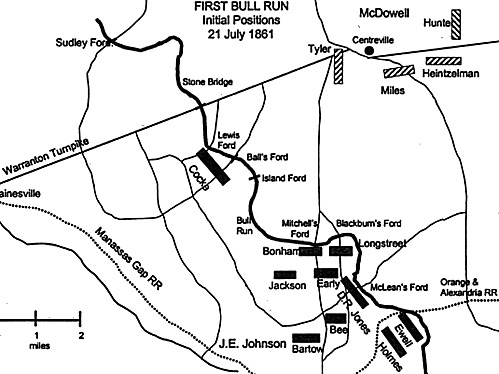
McDowell's plan was really quite elegant. Tyler's Division (minus Richardson's Brigade) would make a serious demonstration at the Stone Bridge. Meanwhile, Hunter's and Heintzelman's Divisions would make a long enveloping march, cross Bull Run at Sudley Springs Ford, and attack southeast rolling up the entire confederate line. Tyler would eventually cross the Stone Bridge and join the attack but Miles' Division would remain protecting Centreville.
Beauregard expected the main federal attack to develop on the most direct route to Manassas Junction and therefore he positioned the bulk of his force to cover Mitchell's, Blackburn's, and McClean's Fords. He placed Cocke at Lewis Ford, and Evans at the Stone Bridge.
Tyler got off to a slow start which delayed Hunter and Heintzelman behind him. At the Stone Bridge, Tyler's demonstration was not convincing and Colonel Evans, defending at the Stone Bridge, became aware of the threat to the far left of the confederate line. Taking it upon himself, Evans redeployed the bulk of his brigade toward the threat at Sudley Springs Ford.
The first fight developed on Matthews Hill. Two federal brigades pushed Evans hard. Finally Beauregard and Johnston became aware of the serious threat to their left flank. Beauregard decided, and Johnston backed him up, to send the brigades of Bee and Bartow to reinforce Evans. Jackson was ordered to move his brigade toward Henry House Hill. Although outnumbered, the confederates put up a stout resistance on Matthews Hill until numbers grew too disproportionate. Sherman managed to get his brigade across an unguarded portion of Bull Run and threatened the confederate line atop Matthews Hill. The confederates withdrew and reestablished themselves on Henry house Hill.
This was the first major engagement of the war and the inexperienced and poorly trained troops reacted as expected. They were difficult to control and slow to respond to orders. Units became combat ineffective after only a short time in action and after receiving relatively few casualties. McDowell, instead of staying in one place and issuing orders to divisions, rode from regiment to regiment getting them to do his will. Neither Beauregard nor Johnston visited the fight on Matthews Hill in order to add the moral weight of their command presence.
Henry House Hill is a plateau - the top is quite flat. The Confederates rallied there. Jackson kept his men on the eastern slope where they were protected somewhat from the federal fires. Bartow and Bee were killed in action and their men shaken but Beauregard managed to stitch together a cohesive line of defense. Johnston moved to the rear to hurry up reinforcements while Beauregard took charge of fighting the battle.
McDowell sent two artillery batteries to Henry House Hill in order to soften up the Confederate line while the federals gathered to conduct an assault. This was virtually suicide as the accuracy and range of the confederate rifled muskets tore into man and beast alike. Finally the battle devolved into disjointed regimental size attacks moving back and forth across the top of Henry House Hill. Brigade and division commanders personally led some of these regimental sized assaults and suffered more than their fair share of wounds. Eventually Beauregard managed to get a few fresh regiments on the far right of the union line and their attack was enough to prompt a yankee withdrawal.
The rest of the tale is well known. The federal troops lost all cohesion and broke up into small bands scrambling for the rear. A couple union regiments protected the withdrawal but McDowell had no divisions left to command. Truth be known, the confederates were elated with their hard-won victory but were too disorganized themselves to pursue in strength. Thus ended the First Battle of Bull Run. The union suffered approximately three thousand out of 35,000 while the confederates lost about two thousand out of 32,000. The battle could have gone either way. McDowell had a suitable plan that could have worked if his subordinate commanders could keep their brigades moving. As it was, the confederates managed to bring a preponderance of fresh troops onto the union flank and the inexperienced Yankees broke first.
Going It Alone: The Solo Wargamers Corner First Bull Run (part I):
-
Introduction
The Preliminaries
Orders of Battle: USA and CSA
The Battle
Solo Rules
Cohesion, Command, and Control
Going It Alone: The Solo Wargamers Corner First Bull Run (part II):
Back to MWAN # 121 Table of Contents
Back to MWAN List of Issues
Back to MagWeb Magazine List
© Copyright 2003 Hal Thinglum
This article appears in MagWeb (Magazine Web) on the Internet World Wide Web.
Other articles from military history and related magazines are available at http://www.magweb.com